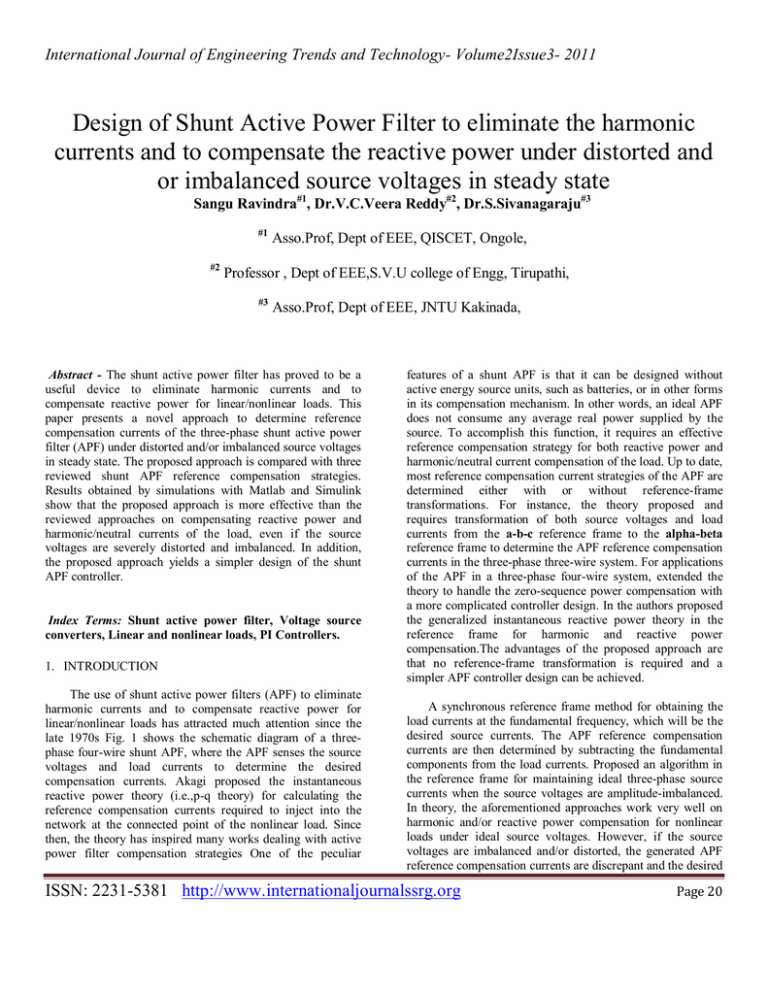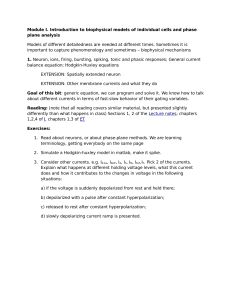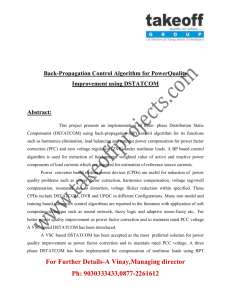Design of Shunt Active Power Filter to eliminate the harmonic
advertisement

International Journal of Engineering Trends and Technology- Volume2Issue3- 2011 Design of Shunt Active Power Filter to eliminate the harmonic currents and to compensate the reactive power under distorted and or imbalanced source voltages in steady state Sangu Ravindra#1, Dr.V.C.Veera Reddy#2, Dr.S.Sivanagaraju#3 #1 #2 Asso.Prof, Dept of EEE, QISCET, Ongole, Professor , Dept of EEE,S.V.U college of Engg, Tirupathi, #3 Asso.Prof, Dept of EEE, JNTU Kakinada, Abstract - The shunt active power filter has proved to be a useful device to eliminate harmonic currents and to compensate reactive power for linear/nonlinear loads. This paper presents a novel approach to determine reference compensation currents of the three-phase shunt active power filter (APF) under distorted and/or imbalanced source voltages in steady state. The proposed approach is compared with three reviewed shunt APF reference compensation strategies. Results obtained by simulations with Matlab and Simulink show that the proposed approach is more effective than the reviewed approaches on compensating reactive power and harmonic/neutral currents of the load, even if the source voltages are severely distorted and imbalanced. In addition, the proposed approach yields a simpler design of the shunt APF controller. Index Terms: Shunt active power filter, Voltage source converters, Linear and nonlinear loads, PI Controllers. 1. INTRODUCTION The use of shunt active power filters (APF) to eliminate harmonic currents and to compensate reactive power for linear/nonlinear loads has attracted much attention since the late 1970s Fig. 1 shows the schematic diagram of a threephase four-wire shunt APF, where the APF senses the source voltages and load currents to determine the desired compensation currents. Akagi proposed the instantaneous reactive power theory (i.e.,p-q theory) for calculating the reference compensation currents required to inject into the network at the connected point of the nonlinear load. Since then, the theory has inspired many works dealing with active power filter compensation strategies One of the peculiar features of a shunt APF is that it can be designed without active energy source units, such as batteries, or in other forms in its compensation mechanism. In other words, an ideal APF does not consume any average real power supplied by the source. To accomplish this function, it requires an effective reference compensation strategy for both reactive power and harmonic/neutral current compensation of the load. Up to date, most reference compensation current strategies of the APF are determined either with or without reference-frame transformations. For instance, the theory proposed and requires transformation of both source voltages and load currents from the a-b-c reference frame to the alpha-beta reference frame to determine the APF reference compensation currents in the three-phase three-wire system. For applications of the APF in a three-phase four-wire system, extended the theory to handle the zero-sequence power compensation with a more complicated controller design. In the authors proposed the generalized instantaneous reactive power theory in the reference frame for harmonic and reactive power compensation.The advantages of the proposed approach are that no reference-frame transformation is required and a simpler APF controller design can be achieved. A synchronous reference frame method for obtaining the load currents at the fundamental frequency, which will be the desired source currents. The APF reference compensation currents are then determined by subtracting the fundamental components from the load currents. Proposed an algorithm in the reference frame for maintaining ideal three-phase source currents when the source voltages are amplitude-imbalanced. In theory, the aforementioned approaches work very well on harmonic and/or reactive power compensation for nonlinear loads under ideal source voltages. However, if the source voltages are imbalanced and/or distorted, the generated APF reference compensation currents are discrepant and the desired ISSN: 2231-5381 http://www.internationaljournalssrg.org Page 20 International Journal of Engineering Trends and Technology- Volume2Issue3- 2011 balanced/ sinusoidal source currents cannot be maintained .Among many approaches for determining the APF reference compensation currents, one of the mainstreams is to maintain sinusoidal source currents supplying average real power to the load. With the use of sinusoidal source current strategy, it is proved that the APF can have better performance than other strategies .To achieve full compensation of both reactive power and harmonic/neutral currents of the load, this paper presents a novel approach to determine the shunt APF reference compensation currents, even if the source voltages and load currents are both imbalanced and distorted. The proposed approach is similar to those presented; it is an reference-frame-based method and is categorized as a sinusoidal source current strategy. In the paper, a brief review of the three approaches proposed in first described. Next, the theory of the proposed strategy is presented. The Matlab/Simulink simulations are then followed to compare the usefulness of the proposed method and the reviewed approaches. A three-phase system feeding an inverter load has been selected to study the performance of the APF system. It has been observed that due to the non-linear characteristics of power electronics loads the THD’s of source current and terminal voltage fall well below the IEEE-519 standard and in principle APF system is used to inject a current equal in magnitude but in phase opposition to harmonic current to achieve a purely sinusoidal current wave inphase with the supply voltage. Figure 1 shows the single-line diagram of a simple power system with APF system ON. The heart of the APF system is the IGBT based voltage source inverter (VSI). A dc capacitor is used to deliver power for the VSI. For the successful operation of APF, capacitor voltage should be at least 150 % of maximum line-line supply voltage. Since the PWM VSI is assumed to be instantaneous and infinitely fast to track the compensation currents, it is modeled as a current amplifier with unity gain. II. SHUNT ACTIVE POWER FILTER A. DETERMINATION OF APF COMPENSATION CURRENTS: Fig.1. Schematic diagram of three phase four wire shunt active power filter with linear & nonlinear loads Active filters are implemented using a combination of passive and active (amplifying) components, and require an outside power source. Operational amplifiers are frequently used in active filter designs. These can have high Q, and can achieve resonance without the use of inductors. However, their upper frequency limit is limited by the bandwidth of the amplifiers used. Multiple element filters are usually constructed as a ladder network. These can be seen as a continuation of the L,T and π designs of filters. More elements are needed when it is desired to improve some parameter of the filter such as stop-band rejection or slope of transition from pass-band to stop-band. REFERENCE The proposed compensation strategy of the active power filter is based on the requirement that the source currents need to be balanced, undistorted, and in phase with the positivesequence source voltages. The goals of the shunt APF control are: 1) unity source power factor at positive-sequence fundamental frequency; 2) minimum average real power consumed or supplied by the APF; 3) harmonic current compensation; and 4) neutral current compensation. Therefore, the active power filter must provide full compensation (i.e., harmonic/neutral currents and reactive power) for the nonlinear load. To achieve these goals, the desired three-phase source currents must be in phase with the positive-sequence fundamental source voltage components. III. VOLTAGE SOURCE CONVERTERS A. VSC BASED TRANSMISSION: The fundamentals of VSC transmission operation may be explained by considering each terminal as a voltage source connected to the AC transmission network via a three-phase reactor. The two terminals are interconnected by a DC link..4 Fig: 2 shows a phasor diagram for the VSC converter connected to an AC network via a transformer inductance. The fundamental voltage on the valve side of the converter ISSN: 2231-5381 http://www.internationaljournalssrg.org Page 21 International Journal of Engineering Trends and Technology- Volume2Issue3- 2011 transformer, i.e. UV(1), is proportional to the DC voltage as been expressed in Eq(1). UV(1) = kuUd ---------- (1) The quantity ku can be controlled by applying additional number of commutation per cycle, i.e. applying pulse with modulation (PWM). Using the definition of the apparent power and neglecting the resistance of the transformer results in the following equations for the active and reactive power: The active and reactive power will in the following be defined as positive if the powers flow from the AC network to the converter. The phase displacement angle δ will then be positive if the converter output voltage lags behind the AC voltage in phase. The active power or the DC voltage is controlled by the control of δ and the reactive power is controlled by the control of the modulation index (m). The instantaneous real and imaginary power of the inverter on the valve side can be expressed in terms of the dq. IV. TWO AXIS REPRESENTATION OF CURRENTS 3-PHASE The control strategy of the active filter is based on the generation of reference source currents. These reference source currents are generated using synchronous frame reference theory (SRF). The load currents (ila, ilb, ilc), PCC voltages (va, vb, vc) and dc link voltage (Vdc) are sensed and used as feedback signals. The load currents in abc coordinates are transformed in to d-q coordinates using Park’s transformation. The d-q components of the load currents are calculated as, 2 2 cos cos cos ila i ld 2 3 3 ilb i lq 3 sin sin 2 sin 2 i lc 3 3 ……. (2) Fig:2 Phasor diagram of VSC and direction of power flows Where cosθ and sinθ are obtained from three phase PLL. These d-axis and q-axis currents can be separated into two parts namely average and oscillatory parts as, ild ild ild ilq ilq ilq B. OUTER ACTIVE AND REACTIVE POWER AND VOLTAGE LOOP: …….. (3) …….. (4) The reference source currents in d-q coordinates are transformed into abc coordinates using inverse Parks transformation and it is expressed as, cos sin ia* 2 2 * 2 ib 3 cos 3 sin 3 ic* 2 2 cos sin 3 3 * id i* q …….. (5) 1) PWM CURRENT CONTROLLER: Fig: 3 Overview diagram of the VSC control system The reference source currents (i*a, i*b and i*c) are compared with the sensed source currents (ia, ib and ic). The ON/OFF switching patterns of the gate drive signals to the IGBTs are generated from the PWM current controller. The current errors are computed as, ISSN: 2231-5381 http://www.internationaljournalssrg.org Page 22 International Journal of Engineering Trends and Technology- Volume2Issue3- 2011 iaerr i*a - ia ; iberr i *b - ib ; icerr i *c - ic . …… (6) These current error signals are fed to a carrier less PWM current controller for switching of the IGBTs of the VSC of the active filter. PI controller Vdc Vdcref ila ilb ilc abc ild LPF ild PI controller Vdcref i*a i d-q-o * d i*b i*c Hysteresis Gating current Signals controller …… (9) These current error signals are fed to a carrier less PWM current controller for switching of the IGBT of the VSC of the active filter. Vdc iloss abc d-q-o iaerr i*a - ia ; iberr i *b - ib ; icerr i*c - ic . ila i lb ilc Active power measurent 0 i* LPF P 2 3 I loss Ilp Ip Vt Amplitude q va vb vc PLL ia ib ic (cosθ,sinθ) va vb vc ua in-phase unit u templates b uc Fig: 4 Gating signals for PWM current controller i i i * a * b * c Hysteresis current controller Gating Signals for 3-leg VSC ia ib i c 2) PWM FOR POWER BALANCE THEORY: Fig: 5 Gating signals for Carrier less PWM current controller The control strategy of the active filter is based on the generation of reference source currents. The reference source currents are generated using power balance theory (PBT). The load currents (ila, ilb, ilc), PCC voltages (va, vb, vc) and dc link voltage (Vdc) are sensed and used as feedback signals. V. SIMULATION RESULTS Three phase voltages at the generator terminals (va, vb and vc) are sensed and amplified to compute their amplitude as, Vt 2 2 v a v 2b v 2c 3 ……. (7) The dc bus voltage error Vdcer at nth sampling instant is expressed as, Vdcer ( n ) Vdcref ( n ) - Vdc ( n ) ……… (8) Where Vdcref is the reference dc voltage and Vdc(n) is the sensed dc link voltage of the CC-VSC. The output of the PI controller for maintaining the dc bus voltage of the CC-VSC at the nth sampling instant is expressed as, Fig:6 Total Hormin distorsion in output voltage for unbalanced supply voltages The reference source currents (i*a , i*b and i*c) are compared with the sensed source currents (ia , ib and ic). The ON/OFF switching patterns of the gate drive signals to the IGBTs are generated from the PWM current controller. The current errors are computed as, ISSN: 2231-5381 http://www.internationaljournalssrg.org Page 23 International Journal of Engineering Trends and Technology- Volume2Issue3- 2011 compared with three reviewed shunt APF reference compensation strategies. Among many approaches for determining the APF reference compensation currents, one of the mainstreams is to maintain sinusoidal source currents supplying average real power to the load. With the use of sinusoidal source current strategy, it is proved that the APF can have better performance than other strategies. VII REFERENCES [1] Fig:7 Total Hormin distorsion without active filter for nonlinear loads Fig:8 Total Hormin distorsion with active filter VI CONCLUSION This is the only method when the loads may be balanced/unbalanced, linear/non-linear and any distortion the source current must be sinusoidal. Because of this we can preferred this proposed approach method. The AF is observed to eliminate the harmonic and reactive components of load current resulting in sinusoidal and unity power-factor source currents. It is observed that the source current remains below the load current even during transient conditions. The AF enhances the system efficiency because the source need not process the harmonic and reactive power demanded by the load. This paper presented a novel approach to determine reference compensation currents of the three phases shunt active power filter (APF) under distorted and/or imbalanced source voltages in steady state. The proposed approach was H. Akagi, Y. Kanazawa, A. Nabae,“Generalize Theory of the Instantaneous Reactive Power in Three-Phase Circuits”, IPEC'83 - Int. Power Electronics Conf., Tokyo, Japan, 1983, pp. 1375 1386. [2] H. Akagi Y. Kanazawa, A. Nab “Instantaneous Reactive Power Compensator Comprising Switching Devices without Energy Storage Components”, IEEE Trans. Industry \ Applic., vol. 20, May/June 1984. [3] E. H. Watanabe, R. M. Stephan, M. Aredes, “New Concepts of Instantaneous Active and Reactive Powers in Electrical Systems with Generic Loads”, IEEE Trans. Power Delivery, vol. 8, no. 2, April 1993, pp. 697-703. [4] M. Aredes, E. H. Watanabe, “New Control Algorithms for Series and Shunt Three-Phase Four- Wire Active Power Filters”, IEEE Trans. Power Delivery, vol 10, no. 3, July 1995, pp. 1649-1656. [5] J. L. Afonso, C. Couto, J. S. Martins, “Active Filters with Control Based on the p-q Theory”,IEEE Industrial Electronics Society Newsletter, vol. 47, nº 3, Set. 2000, pp. 5-10. [6] J. L. Afonso, H. R. Silva, J. S. Martins, “Active Filters for Power Quality Improvement”, IEEE Power Tech’2001, Porto, Portugal, 10-13 Set. 2001. [7] Simulink – Model-Based and System-Based Design, Modelling, Simulation,Implementation version 5,The MathWorks, July 2002. [8] IEEE Working Group on Nonsinusoidal Situations: Efects on Meter Performance and Definitions of Power, “Practical definitions for powers in systems with nonsinusoidal waveforms and unbalanced loads: a discussion,” IEEE Trans. Power Delivery, vol. 11, no. 1, pp. 79–101, Jan. 1996. [9] A. E. Emanuel, “Summary of IEEE Standard 1459: definitions for the measurement of electric power quantities under sinusoidal, nonsinusoidal, balanced, or unbalanced conditions,” IEEE Trans. Ind. Appl., vol. 40, no. 3, pp. 869–876, May/Jun. 2004. ISSN: 2231-5381 http://www.internationaljournalssrg.org Page 24




